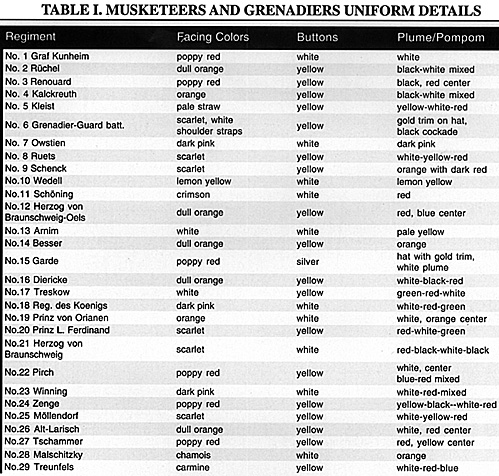In 1788, the tricorn worn by the Musketeers and the
miter-cap of the Grenadiers had been replaced with the so-
called "casquet," but a different tricorn was reintroduced in
1797 on which the plumes and cords were in regimental
colors. At the same time, the Grenadiers (with the exception
of the Guard, which retained its miter-cap) received caps of a
new style with a black leather plate trimmed with black wool.
The back of the plate was painted in the regimental color.
[8]
The leather peak was trimmed with white lace and
above it was a brass badge with the black Eagle below a
grenade. The left side of the cap was ornamented with a
white plume. The hairstyle was also changed and the
practice of powdering the hair was only retained for parade.
In addition, the queue was somewhat shortened, and NCOs,
Schijtzens and Grenadiers wore mustaches though
Musketeers did not.
At the same time, a new infantry tunic was
introduced. It was more tailored and was cut in a frocked
style. The white linen waistcoat was replaced by a false
waistcoat sewn into the tunic. The lapels and turnbacks
were sewn down and the lapels now ran straight down and
were hooked together at the lower edge. Only the tails were
lined in red. The collar was soft, higher and wider than that of the previous tunic.
This new, cheaper-to-produce tunic was of much lower
quality than that of the previous uniform and it became very
unpopular. The Grenadier Guard battalion retained its old
1740 uniform for parade, but the cheaper tunic of the new
style with a gold trim was worn for active service. The
ammunition pouch was black
[9]
and was held by a white belt over the left shoulder. Each
private was provided with a short saber held by a white
waist belt. A brown calfskin sidesack held by a white belt
over the shoulder and a green linen breadbag fixed on a
linen or leather strap completed the equipment.
White knee breeches
[10]
and black gaiters were now worn for parades but in the
field they were covered with twill overalls. In September
1806, a greatcoat was to be provided for the infantry, but
with the Campaign of 1806 starting on October 8 only the
men in East Prussia and Silesia were supplied with them for
the winter campaign of 1806-7. On the other hand, in the
field, most of the officers wore a blue overcoat (as shown in
the drawing below) worn over undress tunic and overalls.
The regimental distinctions were very complicated. In
addition to specific button and plume colors, each regiment
was identified by the regimental colors at the collar,
turnbacks and lapels. In the table below, we provide only
the basic distinctive regimental colors, button, and plume or
pompom colors, i.e. the essential color instructions for
painting a wargame army.
Both the Musketeer regiments and the Grenadier
battalions" were numbered for the sake of convenience but
named after their commanding officers:

| TABLE 1. MUSKETEER AND GRENADIER UNIFORM DETAILS | ||||
|---|---|---|---|---|
| Regiment | Facing Color | Buttons | Plume/Pompom | |
| NO.31 KROPFF | PINK | YELLOW | WHITE-YELLOW-PINK | |
| NO.32 FUERST HOHENLOHE | CHAMOIS | YELLOW | RED-WHITE-BLUE-YELLOW | |
| NO.33 ALVENSLEBEN | WHITE | YELLOW | WHITE-ORANGE-RED | |
| NO.34 PRINZ FERDINAND | POPPY RED | WHITE | WHITE-BLUE-WHITE-RED | |
| NO.35 PRINZ HENRICH | SULFUR YELLOW | WHITE | RED-WHITE-RED-WHITE | |
| NO.36 PUTTKAMER | WHITE | WHITE | BLUE, WHITE CENTER | |
| NO.37 TSCHEPE | CARMINE | WHITE | RED, WHITE CENTER | |
| NO.38 PELCHRZIM | SCARLET | YELLOW | WHITE-ORANGE-WHITE | |
| NO.39 ZASTROW | WHITE | YELLOW | WHITE | |
| NO.40 SCHIMONSKY | DARK PINK | WHITE | WHITE WITH DARK PINK RING | |
| NO.41 LETTOW | LIGHT CRIMSON | YELLOW | CRIMSON WITH WHITE RING | |
| NO.42 PLOTZ | ORANGE | YELLOW | WHITE WITH ORANGE RING | |
| NO.43 STRACHWITZ | ORANGE | WHITE | ORANGE, WHITE CENTER | |
| NO.44 HAGKEN | CHAMOIS | YELLOW | BLACK, LIGHT BLUE CENTER | |
| NO.45 ZWEIFFEL | LEMON YELLOW | YELLOW | RED-BLACK-YELLOW | |
| NO.46 THILE | SCARLET | YELLOW | RED-YELLOW-BLACK | |
| NO.47 GRAWERT | LEMON YELLOW | YELLOW | YELLOW, RED CENTER | |
| NO.48 KURFORST V. HESSEN | POPPY RED | WHITE | BLUE-BLACK-ORANGE | |
| NO.49 MUFFLING | WHITE | WHITE | ORANGE, BLUE CENTER | |
| NO.50 SANITZ | LIGHT CRIMSON | WHITE | CRIMSON-RED-CRIMSON-RED | |
| NO.51 KAUFFBERG | LEMON YELLOW | WHITE | BLUE-YELLOW CENTER | |
| NO.52 REINHART | SCARLET | WHITE | WHITE-BLUE-RED | |
| NO.53 JUNG-LARISCH | LIGHT YELLOW | YELLOW | WHITE, RED CENTER | |
| NO.54 NATZMER | CHAMOIS | WHITE | CRIMSON, YELLOW CENTER | |
| NO.55 MANSTEIN | CRIMSON | YELLOW | CRIMSON-YELLOW-WHITE | |
| NO.56 GRAF TAUENTZEIN | SCARLET | WHITE | SCARLET | |
| NO.57 GREVENITZ | DARK PINK | YELLOW | WHITE, DARK PINK CENTER | |
| NO.58 COURBIERE | LIGHT YELLOW | WHITE | WHITE, LIGHT YELLOW CENTER | |
| NO.59 GRAF WARTENSLEBEN | WHITE | YELLOW | WHITE, CRIMSON CENTER | |
| NO.60 CHLEBOWSKY | LEMON YELLOW | YELLOW | WHITE, BLACK AND ORANGE MIXED CENTER | |
Prussian Uniforms of the 1806 Campaign Part I: The Line Infantry
Back to Empire, Eagles, & Lions Table of Contents Vol. 2 No. 4
Back to EEL List of Issues
Back to MagWeb Master Magazine List
© Copyright 1994 by Emperor's Headquarters
This article appears in MagWeb (Magazine Web) on the Internet World Wide Web.
Other articles from military history and related magazines are available at http://www.magweb.com
